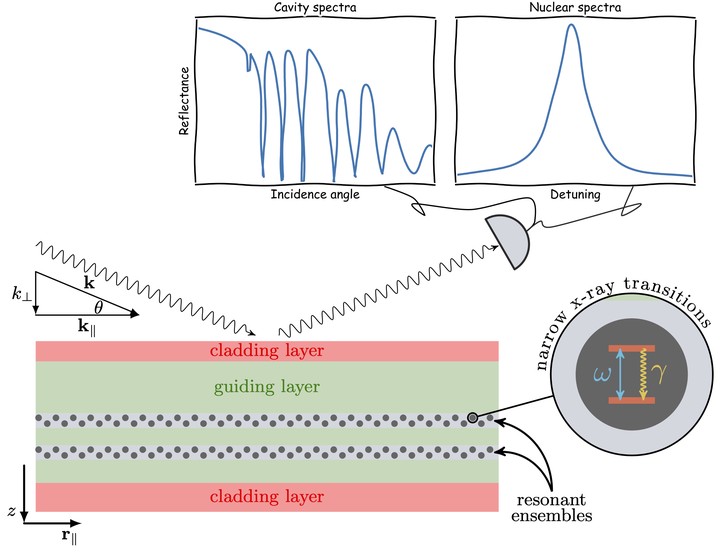Nuclear quantum optics
 A schematic setup for X-ray cavity QED with ultra-narrow resonances. Image from our preprint.
A schematic setup for X-ray cavity QED with ultra-narrow resonances. Image from our preprint.
When thinking of nuclei and quantum optics, the first topics that come to mind are nuclear magnetic resonance (NMR) and diamond vacancy centers. However, there is more! Many nuclei feature ultra-narrow transitions in the hard X-ray domain, which can be excited by radioactive sources or modern X-ray facilities, such as X-ray free electron lasers (XFELs). These systems provide a promising candidate for the new field of X-ray quantum optics [1-2]. Compared to the alternative electronic resonances at these energies, nuclei provide excellent coherence properties, promising access to truly quantum phenomena.
For example, Mössbauer nuclei feature incredibly low decoherence, with quality factors of 1012 up to 1024, often outcompeting even the best superconducting qubits in this regard, which are nowadays being used to build quantum computers. While this simple feature hints at what an exciting platform these nuclei provide, it is clear that we are not going to build a nuclear quantum computer any time soon. One main reason is that operating these extreme quantum systems is challenging.
A big part of my PhD research is to find out how far modern X-ray sources can take Mössbauer nuclei in the quantum direction. The big questions include:
- How do we drive the transitions efficiently?
- Which quantum dynamical processes can be induced?
- Can we achieve non-linear effects?
- How to detect quantum effects and correlations of the X-ray light?
- How to obtain nuclear observables?
One exciting platform to investigate these questions is nuclear cavity QED, where the interaction between X-rays and nuclei is enhanced by a thin-film material stack (see figure), which in effect behaves much like a Fabry-Perot cavity in the optical regime. One can achieve collective effects in this setup, which have already been investigated extensively in the semi-classical sector at low excitations [3-9]. The idea here is that in addition to the astonishing development in X-ray source technology of the last decades, we will also require control techniques (see also the related project on coherent control) and tailored systems to make progress.
The main goal of answering the questions above is to see if we can achieve quantum effects, which would provide a completely new platform for quantum dynamics with extreme transitions. At the same time, quantum effects could be used to improve the many existing applications of these systems, ranging from materials science to metrology. I develop theoretical methods to answer these questions, and also contribute to and perform experiments at large scale X-ray facilities to investigate the effects that we find.
External references
[1] B. W. Adams et al. Journal of Modern Optics, 60, 2-21 (2013)
[2] B. W. Adams et al. arXiv:1903.09317 (2019)
[3] R. Röhlsberger et al. Science 328, 1248 (2010)
[4] R. Röhlsberger et al. Nature 482, 199–203 (2012)
[5] K. P. Heeg et al. Phys. Rev. Lett. 111, 073601 (2013)
[6] K. P. Heeg et al. Phys. Rev. Lett. 114, 207401 (2015)
[7] K. P. Heeg et al. Phys. Rev. Lett. 114, 203601 (2015)
[8] J. Haber et al. Nat. Photon. 10, 445–449 (2016)
[9] J. Haber et al. Nat. Photon. 11, 720–725 (2017)
Related publications
K. P. Heeg et al. Science 357, 375 (2017)
D. Lentrodt et al. arXiv:2003.13859 (2020)